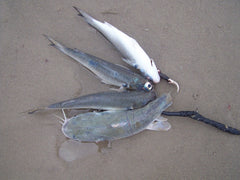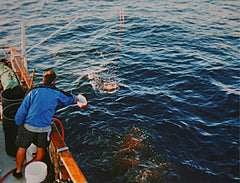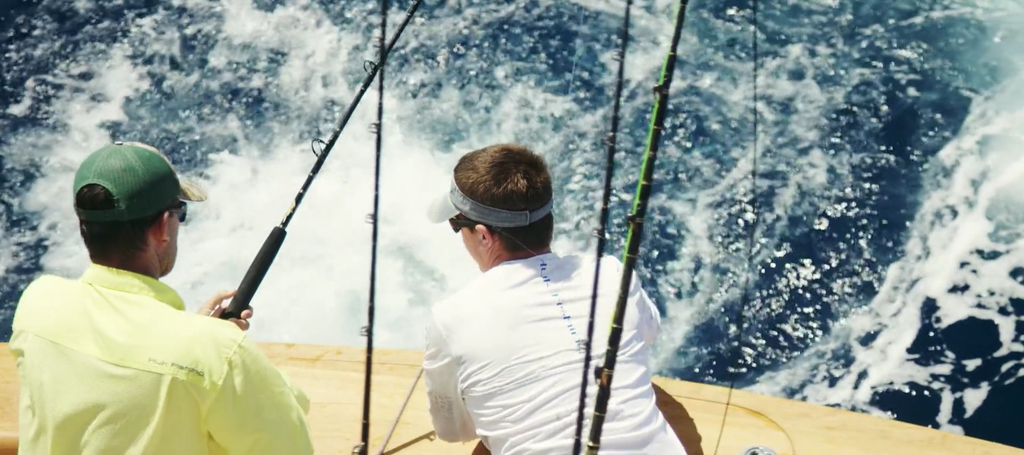Sharks are the most savage creatures in the ocean. And although they're often considered bycatch when fishing for other big game species, sharks make incredible targets in their own right. If you're looking for a new fishing challenge and like the idea of tangling with these voracious, toothy beasts, this article will teach you everything you need to help you get started deep sea fishing for sharks.

Shark Species Breakdown
While most of the shark species sport anglers catch can be found in oceans worldwide, there are some regional variances in what you'll catch. If you're fishing in the Gulf of Mexico or the mid-Atlantic, chances are you'll catch more blacktips, spinners, and bull sharks than anything else. In the Pacific Ocean, however, you'll see a lot more blue sharks and the extremely volatile mako sharks.
Shark-Ready Rods & Reels

Unlike other big game offshore fishing, many shark anglers reach for slightly lighter rods and reels than what you might expect. You'll often hook up on dozens of sharks during a day of fishing. Lighter tackle allows you to rack up the numbers with less fatigue.
Here's a great all-purpose set up that's ideal for stand up shark fishing:
- Reels: Lever drag reels are essential. Shimano Tiagra 50Ws are standard when fishing with bent-butt rods strapped into fighting chairs, but to stay on the lighter side for stand up fishing, smaller reels such as the Shimano Talica 25s are perfect.
- Rods: There are many excellent offshore rods for shark fishing but one of the best is the Shimano Terez which is very light considering how strong it is and designed specifically for use with braided line.
- Line: 80-pound test braided line should be used as your main line, and you should spool your reel with at least 600 yards. Most shark anglers add a top shot of around 50 to 100 yards of 80-pound test monofilament to their braided lines. Since monofilament stretches, it provides shock absorption that keeps the hook from pulling out of the shark's mouth during surging runs and acrobatic aerials.

Shark-Proof Rigs
The terminal tackle rigs used to catch sharks are relatively simple with one key distinction—heavy-duty wire is the main ingredient. Without wire, a shark's sharp teeth will cut through monofilament like butter.
Let's walk through a basic deep sea fishing for sharks rig:
- A 15-foot length of 480-pound test multi-strand American Fishing Wire cable is tied or crimped to the monofilament top shot.
- A 10-foot length of 240-pound test single strand wire is connected to the multi-strand cable using a 500-pound test swivel.
- A long-point big game hook is attached to the 240-pound single strand wire. The size of the hook should be based on the size of bait being used, anywhere from 8/0 to 11/0. Or if you're targeting a specific species, go with 6/0 to 10/0 for sharks under 6 ft and 16/0 to 20/0 for behemoths over 8 ft.
This shark-proof rig can be used as is for flat-lined drifting and pitching. For fishing slightly deeper or in faster current, the 500-pound test swivel is swapped out for a weighted 3-ounce swivel. If the current is very strong, additional weight can be attached to the line using rubber bands.
Finding Blue Water & Structure
While you can find sharks inshore and nearshore, the best action by far is offshore in the blue water. Expect a long run from port to get to the blue water. Once there, start scouring your charts to find structure—reefs, wrecks, ledges, banks, seamounts, etc. The theory is baitfish congregate around structure which draws in the sharks for meal time. These are the areas you should target when deep sea fishing for sharks.

Setting The Chum Slick
Once a sharky-looking structure has been identified, the next step is to work the boat one or two miles up current of the structure. Then, it's time to prepare the most important part of any shark-fishing pursuit—the chum slick.
Here's how it works:
When predatory fish gorge on baitfish, they burp up fish oil. The oil floats to the surface of the water creating a "slick" spot on the ocean. To attract sharks and draw them into casting range, shark anglers dump hundreds of pounds of chum—ground up fish and fish carcasses—into the water to create a very large version of slicks that naturally occur.
The current broadcasts the chum, and the sharks come in like clockwork.
While setting a chum slick is relatively straightforward, there are a few specific strategies used by shark anglers:
- Two 5-gallon chum buckets full of ground fish are hung off the boat, one on each side of the stern. Once the two are empty, a single chum bucket is hung off one side of the boat mid-ship.
- Two chum sacks full of fish carcasses are hung off either side of the boat. Every ten minutes or so, a deck hand will stomp on the chum sacks to release more fish oil.
- A cooler full of fresh cut bait—bunker, bluefish, and other oily fish—is slowly shoveled into the water off the stern to add meat to the slick.
Fishing The Long Drift

While the chum slick is being set up, the boat is taken out of gear so it can slowly drift toward the target structure. Since setting up chum slick is such a big investment of time and bait, most shark anglers commit to fishing a single slick during the day, drifting just behind it in the current.
As the chum slick becomes more prominent and the boat approaches the structure, shark fins will start to appear, cutting through the chum slick in search of food. That's when the fun starts.
Drifting & Pitching Baits.
Most of the time, three baited lines are in the water during the drift—one long line rigged with a float and weighted swivel is set 250 feet out from the boat, a middle line set 150 feet out with less weight, and a flat line set closer to the boat just out of sight in the slick.
These lines are baited with chunk or strip baits of whatever fish is being used in the chum slick, and during the drift, they are closely monitored as a shark could hit at any moment. However, sharks are by no means shy and will often come right up to the boat and start circling. That's when it's time to pull out the pitching rod.
As soon as a shark comes within casting range of the boat, the pitching rod bait is thrown out. If the cast is good, the shark will likely attack the pitch bait immediately. This is especially true with makos. But if the cast misses its mark, don't worry. Any sharks coming into the slick will be on a mission to find whatever it is that producing all the scent in the water and should have no problem finding your bait.
Setting The Hook On A Shark
When a shark takes the bait, it's important to wait at least five or 10 seconds before setting the hook. This allows the shark to get the bait and hook past its rows of teeth for a better hookset. To set the hook on a shark, you lower the rod tip, reel in tight, then jab the rod upward two times as hard as you can. Once that hook is set, hang on!
Fighting, Landing & Releasing Sharks

If you love the thrill of fighting big, powerful fish, deep sea shark fishing is the game for you. Be ready for lightning fast runs, dives, surges, and crazy leaps and back flips that almost seem impossible.
Unlike other sport fish that you want to fight and land as quickly as possible, it isn't necessary to put a ton of pressure on sharks right away. You need to let the shark get plenty tired before landing and releasing it because a green shark is a dangerous shark. Fight it hard, but let it run and jump as it pleases. That'll wear it out faster.
If you plan on keeping the shark, a crew member needs to have a harpoon or gaff ready to go so that as soon as you bring the shark within range, it's over. Keep your wits about you because as soon as the harpoon hits, that shark will come alive all over again.
For catch and release, it's even more important that everyone on board knows their role and works as a team. The best way to release a shark is in the water with a release stick—a device that looks like a gaff with a metal loop instead of a hook. The metal loop is slid down the leader and is used to twist the hook out of the shark's mouth. Just be sure to have a few extra release sticks on board as a thrashing shark can snap or bend one no problem.
Keep Your Eyes On The Slick
After one shark is released, get ready for many more. Because if you have the right rods and reels rigged up with heavy-duty wire leaders and set up your chum slick like we outlined, you'll find yourself surrounded by slicing fins and gnashing teeth.









